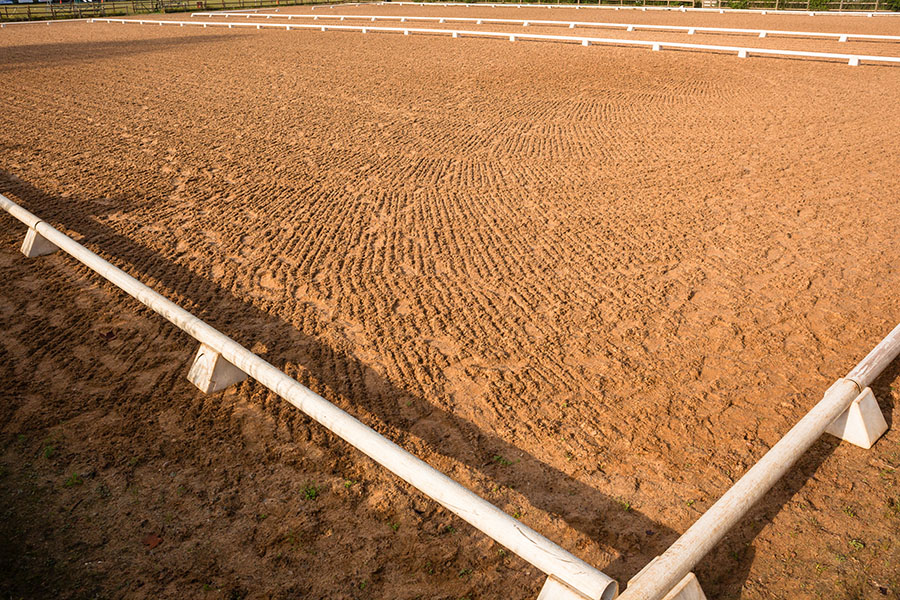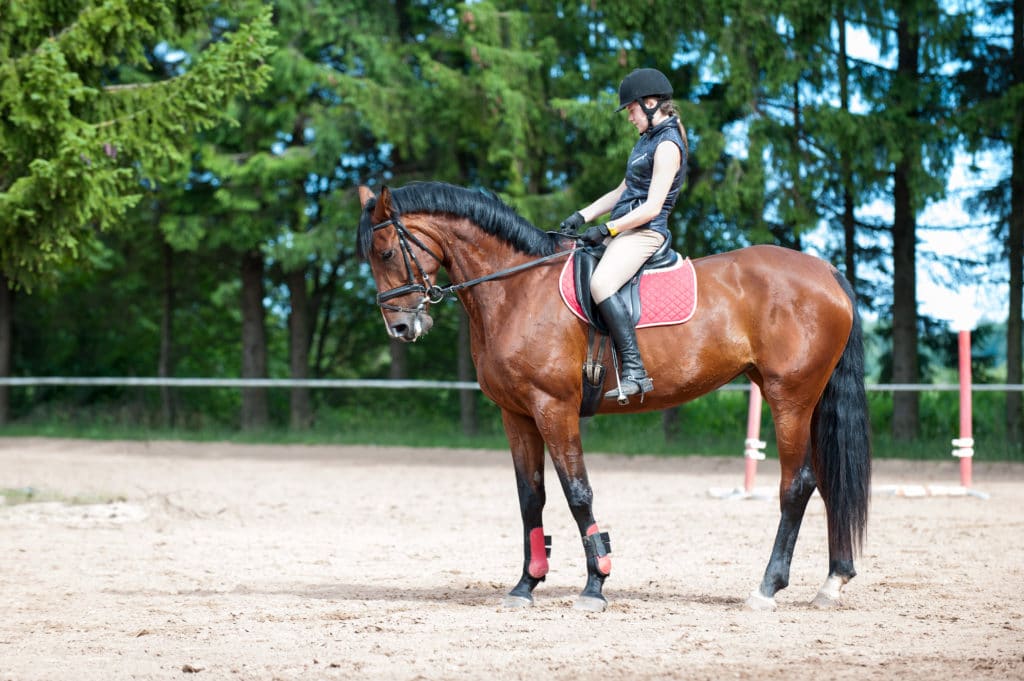When building or modifying a horse arena, choosing the correct footing materials is one of the most important aspects to consider. You can build a beautiful, functional indoor or outdoor arena, but if the footing is ineffective, horses and riders can get hurt. In addition to the type and quality, horse arena footing prices are an important consideration when choosing the proper horse footing.
Whether you are building a small dressage arena, a mid-sized arena, or a large arena, you will need three primary levels. Each of these levels attract different price considerations and are equally important for keeping both horses and humans free from injury:
- The Sub-Base: The unsung hero of any arena, this is where the main structural support comes from. If the natural material cannot withstand the impact of a busy arena schedule, it can be reinforced with geotextiles and geocells.
- The Base: This is the part of the foundation which is often made of clay and higher quality materials. Without a solid base, the horses will not have the support they need to avoid injury.
- The Subsurface: This layer is usually made of or mixed with sand or some type of manufactured material. Oftentimes, the subsurface is just an extension of the top dressing.
- The Top Dressing: This should be integrated with the subsurface to provide the best combination of grip and stability. What combination is right for your arena depends on the type of events you host and how frequently your arena is in use. The top dressing and subsurface combine to form what we consider the footing.
What Are the Types of Footing?
Arena footing constantly evolves as you add to inorganic materials, run your horses, and naturally mix the substances together over time. There are a variety of different footings that you can use to cover your arena surface at various stages of this process, the main deciding factors often being which disciplines your arena hosts and how much money you are willing to invest.
On this topic, Eileen E. Fabian (Wheeler), PH.D. of Penn State University points out that there are two primary, equally viable ways to develop footing.
- Primarily Native Soil: With this method, the owner of the arena spends most of their resources and time manipulating the materials — whether that means watering or shifting — to maintain its quality. According to Wheeler, this method is ideal for arenas that already have strong soil composition to begin with. For those building an arena or completely redoing their footing, this is the cheapest option because it does not require importing tons of materials.
- Primarily Imported Materials: Owners who do not have the luxury of high-quality soil as a base can import their materials. With this method, the outdoor riding arena cost skyrockets, while the footing maintenance decreases. Products that fall into this category include footing additives and soil stabilizers, such as FoamFooting, BaseCore, and even GeoTextiles.
As time passes and as horses run and jump on the arena surface, its footing composition and effectiveness will change. This is due to the footing being mixed with other materials over time such as imported footing materials, dust-prevention additives, and organic waste. During this process, the ideal footing evolves and becomes established over time.
However, it is important to know that there is a tipping point for many arenas. Generally speaking, even the most well maintained footing must be entirely redone at least every 10 years, sometimes even sooner for high traffic arenas. This is due to the simple fact that you can only add so much material to your arena before you need a fresh start to get the soil back to peak performance.

Horse Arena Footing Prices
Depending on the size, location, and footing materials of your arena, the price can vary from $0.70 to $6.00 per square foot. These factors must be considered when calculating your overall horse arena footing prices.
Size of the arena: Aside from the different mix of materials that go into creating the best horse arena footing, the arena’s construction bears weight on the amount of footing you’ll need. Here, you’ll need to consider the length and breadth of the arena.
Location of the arena: Your arena location and whether you are building from scratch or not also determine your specific horse arena footing prices. If the location is an environmentally-sensitive area, it may affect the type of footing you can install in your arena.
Types of footing to be used: Horse arena footing is made from a variety of different materials, each having its own price. As a result, your arena’s footing price will depend on the combination of footing materials you choose to use in your arena.
Whether you’re looking for an arena overhaul or simply interested in materials that you can use in your next tune-up, read below. Here, we have a compilation of the most commonly used materials in addition to some additives that can help take your footing to the next level.
Rubber Mulch
Rubber footing is sometimes mixed with local soil for arena owners who don’t have high-quality soil to implement. Rubber does not absorb moisture so remains slick when wet. As such, for arenas that use watering as their main source of dust control, rubber footing may not be the best option.
Furthermore, rubber mulch retains heat and, depending on your geography, will harden over time. This reduces its effectiveness far sooner and necessitates a more regular maintenance schedule.
Finally, as rubber is a synthetic material, rubber mulch is usually more expensive than other, more natural options, running you $9 per square foot.
Sand
To get decent footing for your arena, you can expect to spend around $1 to $2 per square foot. Sand footing is probably the most common and diverse of these materials and most arenas are going to have some sand included in their footing composition.
For sand-heavy arenas, intense maintenance is required, especially when it comes to finding the right watering schedule. If watered too much, sand can become muddy and inhibit movement. If not watered enough, sand will dry out, become loose and dusty, and cause horses to slip.
One of the main benefits of sand is its cost effectiveness. Since it is so affordable, arena owners can keep their costs lower by including sand in their arenas. It is also very diverse, as you can purchase very fine or very coarse sand or sand that is coated in various waxes to help with texture and resilience.
Stone Dust
Stone dust is made by processing sand and stones through a crushing machine and costs $1.75 to $2.50 per square foot, making it a more expensive product than sand. This results in a very fine, sand-like, powder. Stone dust provides stability and is known to drain without issue
As the name implies, stone dust tends to be very dusty. For the health and safety of both you and your horses, this material needs to be watered regularly and maintained so the dust does not get out of hand. Furthermore, the nature of this material makes it prone to over-compacting, meaning the surface will become hard and no longer provide adequate cushioning to your horses hooves.
The initial cost of stone dust is quite inexpensive. However, stone dust maintenance takes significant time and water, which can make it expensive over time.
As mentioned before, these different footing options are not mutually exclusive. Most arenas contain a combination of different materials. However, there are a variety of additional products that can supplement primary footing which create a much stronger and more effective arena surface.
That’s where Performance Footing comes in.
What Does Performance Footing Offer?
At Performance Footing, we offer three supplementary products for your riding arena: FoamFooting, BaseCore, and Geotextile Fabric. All of these products are made to supplement your existing arena footing to make it more durable and better performing. As horse enthusiasts ourselves, we also made sure these materials would be suited for both indoor and outdoor arenas, at prices affordable to most equestrians.
FoamFooting
Our FoamFooting is an arena footing additive designed for the comfort and safety of you and your horse. As a team of riders, trainers, and product designers, we created this product with the goal of improving footing for a variety of different disciplines. Each bag of Performance Footing premium FoamFooting retails for $119.95 and averages to $.31 per square foot. Regardless of which base and footing materials you have, our FoamFooting comes with a variety of benefits:
- Softens the impact on hooves
- Lessens the amount of dust
- Reduces the amount of watering
- Improves cushioning
- Enables longer training sessions
- Less frequent injuries
- Happier horses
You can easily install the 35 pound bags of FoamFooting. You can use our calculator to determine how much you may need.
BaseCore
Our BaseCore is expandable ground stabilization panels for soil retention of all terrains. These cells provide both vertical and horizontal strength to your base material, acting as individual pockets to hold your substrate in place from heavy traffic or heavy rain. You can expect to pay $149.00 or $1.38 per square foot for 2 bundles of our BaseCore HD™ Geocell, covering 108 square foot. This product allows water to move freely without washing out the material, which protects your top soil, footing base or arena footing additive, saving you money in maintencine over time. It provides significant benefits such as:
- Military-grade strength
- Reinforces the ground to eliminate further erosion
- Reduces the amount of fill needed to form a strong base
- Easy to install without heavy equipment
Geotextile Fabric
Our geotextile fabric is landscape fabric for ground stabilization, weed control and more. Non-woven geotextiles have historically been used for filtration and erosion control and have many other beneficial characteristics which work in combination with our BaseCore geocells. Equestrians can add our puncture and UV resistant geotextile fabric to a 3ft X 360ft horse riding arena for $.28 per square inch or $298.00. This fabric offers significant benefits for equestrian arenas such as:
- Prevents the mixing of a subgrade and an aggregate material
- Helps ensure the longevity of your arena
- Helps stop the formation of holes or uneven foundations caused by temperature changes
More than any other equestrian company, Performance Footing creates reliable horse footing products at affordable prices. We give every customer the best bang for their buck with horse arena necessities they can use for personal use or training facilities, including our FoamFooting, Base Core, and Geotextle Fabrics.
To place an order or learn more about our products, call us at (877)-835-0878 or schedule a free consultation with one of our experts.
